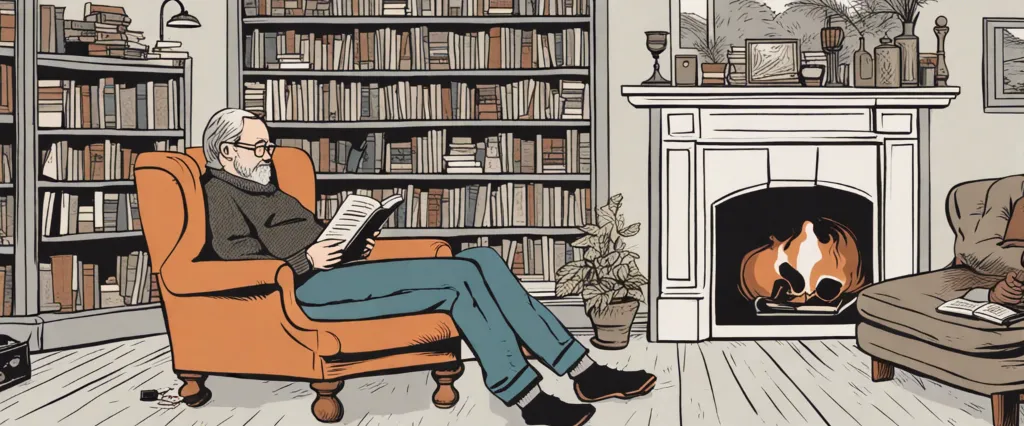In the captivating book “At Home,” author Bill Bryson takes his readers on an enlightening journey through the rooms of his own house. Known for his exceptional storytelling and ability to make history come alive, Bill Bryson delves into the origins, evolution, and cultural significance of household objects found in every home. With his signature wit and charm, Bryson uncovers the rich tapestry of human ingenuity, inspiring readers to see their own homes in a fresh and fascinating perspective. Through the pages of “At Home,” Bryson rekindles the curiosity in us all, reminding us that even the most mundane objects have a compelling story to tell.
Chapter 1: The Year
Chapter 1 of Bill Bryson’s book “At Home” provides an exploration of the historical significance of the year 1851 and its impact on British society. Bryson delves into various aspects of Victorian life, highlighting how this pivotal year represented the beginning of significant changes in architecture, industry, and social conventions.
The chapter begins with an overview of the Great Exhibition, held in London’s Crystal Palace in 1851. This international exhibition showcased Britain’s industrial and technological advancements, symbolizing the country’s dominance during the Victorian era. Bryson describes the incredible size and opulence of the Crystal Palace, serving as a monument to the triumph of industrial progress.
Moving beyond the Great Exhibition, Bryson turns his focus to the homes of the Victorian era. He discusses the rapid urbanization and the rise of the middle class, leading to a demand for affordable housing. This resulted in the construction of thousands of new houses and the development of residential suburbs across Britain. Bryson explores the architectural influences and burgeoning building regulations that accompanied this period of urban expansion.
Furthermore, Bryson touches on the gender roles and the social landscape of Victorian society. He highlights the contrasting experiences of men and women during this era, where women were primarily confined to domestic responsibilities. Bryson examines the various challenges faced by women during this period, including the lack of legal rights and the expectation to conform to societal expectations.
Overall, chapter 1 of “At Home” provides an intriguing glimpse into the year 1851, offering readers a detailed understanding of the significant changes that took place during this transformative period in British history.
Chapter 2: The Setting
Chapter 2 of “At Home” by Bill Bryson provides a detailed exploration of the setting of the book, focusing on the author’s own house in Norfolk, England. Bryson explains that his house was originally built in the early nineteenth century, and he describes its unique features, such as the various architectural styles it encompasses.
The author delves into the history of his house, tracing its ownership and inhabitants over the years. He discovers that the house had once been a rectory and provides insights into the lives of rectors and the role they played in the community. Bryson also highlights the significance of the church in the rectory’s surroundings, pointing out that churches were an integral part of English social life and often served as the hub of villages.
Furthermore, Bryson emphasizes the importance of coal in shaping the development of houses and communities in England. He uncovers the consequences of coal mining on the environment and the health hazards associated with it, such as air pollution and accidents in mines. Bryson stresses that coal was a fundamental ingredient in the development of the Industrial Revolution and played a critical role in transforming Britain into an industrialized nation.
Finally, the chapter touches on the global impacts of English homes and society. Bryson examines the transatlantic connection and explains how the materials and ideas used in English houses spread to other parts of the world, particularly North America. He highlights how the English influence is visible in American homes, from their architectural styles to their homely comforts.
Overall, Chapter 2 serves as an introduction to the setting of “At Home,” providing readers with historical context and insight into the author’s own house while exploring the broader themes of English society, coal, and the global impact of English homes.
Chapter 3: The Hall
Chapter 3: The Hall of the book “At Home” by Bill Bryson takes readers back to a time when halls were a prominent feature in British homes. In traditional homes, the hall was not merely a passageway but an important room that served multiple purposes.
Bryson delves into the historical significance of halls, moving from the grand halls of medieval times to the more simplified versions found in modern homes. He explores the architectural details, discussing how halls were designed to impress visitors and convey wealth and status. Halls often contained large fireplaces, providing warmth in the colder months. They were also adorned with impressive tapestries and paintings, showcasing the family’s heritage.
The author touches on the concept of “swing doors,” which allowed servants to move discreetly around the house. These doors were a crucial element in maintaining the hierarchy within the household.
Bryson then shifts to more contemporary halls, which have commonly been reduced in size and importance. Nowadays, many houses lack proper halls altogether, with their functions dispersed among various rooms. He laments the loss of this grand space and the sense of arrival it provided.
Furthermore, the chapter explores the origins of various everyday phrases and objects related to halls, such as “hallmark,” “hallucinate,” and “hallways.” Bryson’s anecdotes and historical facts provide insight into the evolution of these terms.
In conclusion, Chapter 3 of “At Home” delves into the history and significance of halls in British homes. Bryson emphasizes the architectural beauty, social dynamics, and symbolic meaning of halls, showcasing their transformation over time.
Chapter 4: The Kitchen

Chapter 4 of “At Home” by Bill Bryson delves into the history and significance of the kitchen as a central part of the house. In this chapter, Bryson explores various aspects of the kitchen, from its development and design to the changing technology and its impact on cooking and food storage.
Bryson begins by highlighting the kitchen’s transformation from a separate room to an integral part of the house. He discusses the historical perception of kitchens as dirty, hot, and chaotic spaces due to the slow adoption of modern ventilation and cooking technologies. This notion gradually changed with the introduction of electric appliances and improvements in sanitation, making kitchens more livable and pleasant places.
The author goes on to explore the evolution of kitchen equipment, mentioning key inventions such as gas stoves, refrigerators, and microwaves. This technological progress not only made cooking more efficient but also had a profound impact on social dynamics within the household. With the advent of refrigeration, preserving food became easier, reducing the need for daily marketing and allowing greater independence for household members, particularly women.
Furthermore, Bryson highlights the influential figures who contributed to these advancements. He mentions the efforts of individuals like Fred Waring, who popularized the blender, and Dr. Karl Drais, who developed the precursor to the modern bicycle, which indirectly contributed to culinary progress.
As the chapter concludes, Bryson reflects on the kitchen’s role as a social hub. He explains how kitchens have historically been a gathering place for families and friends, but the rise of convenience foods and eating out has shifted this dynamic. Despite these changes, the kitchen remains a vital part of the home, symbolizing comfort, nourishment, and familial connections.
Overall, Chapter 4 of “At Home” provides a comprehensive overview of the kitchen’s history, technological advancements, and its significance as a social and functional space within the home.
Chapter 5: The Scullery and the Larder
Chapter 5 of “At Home” by Bill Bryson is titled “The Scullery and the Larder.” In this chapter, Bryson explores the less glamorous aspects of household life in the Victorian era, focusing particularly on the scullery and the larder – two essential rooms in any Victorian home.
The scullery, located at the back of the house, was a utility room where dirty dishes were washed, clothes were laundered, and various household tasks were performed. Bryson highlights the hard work required in this room, with women spending long hours scrubbing, boiling laundry, and performing other laborious chores. Despite its physical demands, the scullery was often overlooked in terms of design and comfort, typically being small, cramped, and poorly ventilated.
Bryson then shifts his attention to the larder, an important food storage area. The larder was designed to keep perishable food fresh through various means, such as cool air, ice, or salt. Bryson describes the assortment of foodstuffs typically found in a Victorian larder, including game, dairy products, fruits, and vegetables. The larder required careful management, with servants responsible for monitoring the items stored and ensuring they remained usable.
Throughout the chapter, Bryson emphasizes the immense efforts and labor put into maintaining the scullery and the larder. He also delves into the hierarchy and routines of the servants involved in these tasks. Bryson makes it clear that behind the grandeur of Victorian homes, there existed a complex web of labor and organization to maintain the household’s needs, and the scullery and larder were essential aspects of this system.
Chapter 6: The Fuse Box
Chapter 6: The Fuse Box of the book “At Home” by Bill Bryson delves into the history and importance of the fuse box, an often-overlooked device found in nearly every household. Bryson skillfully uncovers the fascinating origins of this device while showcasing its significance in revolutionizing electrical safety.
Bryson begins by highlighting the overall ignorance and disregard for safety during the early days of electricity. The lack of regulation and understanding of electrical systems led to numerous accidents and fires. It was only when the fuse box was introduced that a sense of order and safety began to take hold.
He takes readers on a historical journey to nineteenth-century England, where the fuse box’s precursor, the fuse board, was invented by Thomas Edison. This inventive device allowed for easily replaceable fuses, preventing electrical overloads and minimizing the chances of a fire.
Bryson then looks at the intertwining relationship between electricity and household devices, emphasizing how their increasing numbers and complexity necessitated the evolution of fuse boxes. As the demand for electricity surged, the role of the fuse box was expanded to accommodate the growing number of circuits and ensure safety throughout the house.
While exploring the various components of a modern fuse box, Bryson encourages readers to reflect on the significance of these unassuming devices. He explains how they offer protection, limit unnecessary power consumption, and guard against electrical emergencies. Bryson also discusses the concerns and precautions homeowners should take regarding the placement, maintenance, and general understanding of their fuse boxes.
In summary, Chapter 6 of “At Home” takes readers on an engaging exploration of the fuse box’s history and importance. Through Bryson’s meticulous research and storytelling, readers gain a newfound appreciation for this often-underappreciated device, which has greatly contributed to the safety and convenience of modern electrical systems in homes worldwide.
Chapter 7: The Bedroom
Chapter 7 of “At Home” by Bill Bryson delves into the history and evolution of bedrooms. Bryson begins by highlighting the significant changes in bedroom designs from the Middle Ages to the 20th century. He explores the concept of privacy, emphasizing how it was nonexistent in ancient times, where entire families shared a single room for sleeping.
Moving forward, Bryson recounts the introduction of the enclosed bedroom during the 18th century. He explains that this shift was predominantly influenced by the increase in wealth and a rising sense of independence. The author intertwines historical anecdotes with his personal experiences, providing an engaging and informative narrative.
Furthermore, Bryson discusses the various elements that make up a bedroom such as the bed, wardrobes, linens, and even the importance of mirrors as social status symbols. He highlights the significance of the invention of the coil spring mattress, which greatly improved comfort and sleep quality.
Moreover, Bryson addresses the societal norms and expectations surrounding bedrooms, focusing on the roles of women and the emergence of separate bedrooms for couples. He sheds light on how the bedroom became a personal sanctuary, a place for intimacy and relaxation, reflecting the changing attitudes towards privacy and comfort.
The chapter concludes by exploring the impact of technology on modern bedrooms, including temperature control, electric lighting, and the advent of televisions. Bryson emphasizes that the bedroom has evolved into a multifunctional space, accommodating a variety of activities beyond sleeping.
Overall, Chapter 7 of “At Home” provides a well-researched and engaging exploration into the evolution of the bedroom, showcasing the changes in design, privacy, and functionality throughout history.

Chapter 8: The Bathroom
Chapter 8 of “At Home” by Bill Bryson is titled “The Bathroom” and explores the history and evolution of one of the most important rooms in the house.
Bryson begins by discussing how the bathroom, specifically the toilet, often represents the limit of our comfort and privacy. He delves into the early days of indoor plumbing, where the design and construction of toilets were challenging and often unpleasant. He explains that the birth of modern toilets can be credited to inventors such as Sir John Harington and Thomas Crapper, who worked towards improving the function and efficiency of these vital fixtures.
The chapter takes a fascinating journey through time, examining the historical and cultural aspects of bathrooms. Bryson explores the development of the concept of privacy in the process, highlighting how bathrooms have evolved from communal spaces to distinctly private areas within our homes. He touches upon the influence of social conventions and etiquette on bathroom habits and design.
Bryson also covers the importance of hygiene and cleanliness in bathrooms. He delves into how the understanding and practices surrounding cleanliness have changed over centuries, and how innovations like the introduction of soap, running water, and germ theory significantly impacted the way we perceive and use bathrooms.
Furthermore, the author examines the paradoxical relationship between the bathroom and disease. He reveals how advancements in water supply and sewerage systems greatly contributed to the eradication of deadly diseases like cholera, while at the same time, bathrooms can still be a breeding ground for germs if not properly maintained.
Overall, Chapter 8 of “At Home” offers a comprehensive overview of the history, architecture, and cultural significance of bathrooms while highlighting the pivotal role they play in our daily lives.
After Reading
In conclusion, “At Home” by Bill Bryson offers a captivating journey through the history and significance of everyday objects found in our homes. With meticulous research and engaging storytelling, Bryson takes readers on an insightful exploration of how these seemingly ordinary items have shaped human civilization and influenced our way of life. From the origins of specific rooms and furniture to the transformative power of technology and hygiene, the book provides a deep appreciation for the numerous ways that our homes reflect the evolution of society. Throughout his narrative, Bryson’s wit and curiosity add a delightful touch, making “At Home” not only an informative read but also an enjoyable one. With this book, readers will never look at their homes the same way again, as they gain a newfound understanding of the immense history and significance that lies within the walls of our personal spaces.
1. The Omnivore’s Dilemma: A Natural History of Four Meals” by Michael Pollan
Written by renowned journalist and author Michael Pollan, “The Omnivore’s Dilemma” is a captivating exploration of America’s complex relationship with food. Pollan delves into the industrial food chain, organic and sustainable farming, and the origins of each individual’s meal. This book, like “At Home,” combines fascinating historical insights with engaging storytelling.
2. The Immortal Life of Henrietta Lacks” by Rebecca Skloot
In “The Immortal Life of Henrietta Lacks,” Rebecca Skloot tells the extraordinary story of a poor African American woman whose cells were unknowingly taken and became the cornerstone of medical research worldwide. Skloot’s masterful blend of science, history, and personal narrative captures the reader’s attention and highlights the impact one person can have on the world. This book shares similarities with “At Home” by examining the hidden stories behind everyday objects and phenomena.
3. Longitude: The True Story of a Lone Genius Who Solved the Greatest Scientific Problem of His Time” by Dava Sobel
Longitude” by Dava Sobel focuses on the incredible journey of John Harrison, an 18th-century English clockmaker who solved the problem of determining longitude at sea. Sobel’s book meticulously recounts this scientific triumph, combining history, biography, and scientific discovery. Just as Bill Bryson reflects on the evolution of human habitation in “At Home,” “Longitude” delves into the impact of technology on navigation and exploration.
4. Salt: A World History” by Mark Kurlansky
For anyone intrigued by the hidden stories behind everyday objects, “Salt” offers an enlightening journey through the history and cultural significance of this seemingly mundane condiment. Mark Kurlansky takes readers from ancient civilizations to modern times, exploring how salt has shaped economies, cultures, and societies worldwide. This book, like “At Home,” demonstrates how seemingly ordinary things can have extraordinary stories.
5. The Emperor of All Maladies: A Biography of Cancer” by Siddhartha Mukherjee
“The Emperor of All Maladies” by Siddhartha Mukherjee provides a comprehensive and captivating account of the history, exploration, and treatment of cancer. Mukherjee combines science, personal stories, and medical breakthroughs to unravel the intricacies of this deadly disease. Similar to Bill Bryson’s approach in “At Home,” Mukherjee sheds light on a complex subject, humanizing it through compelling storytelling and historical context.




